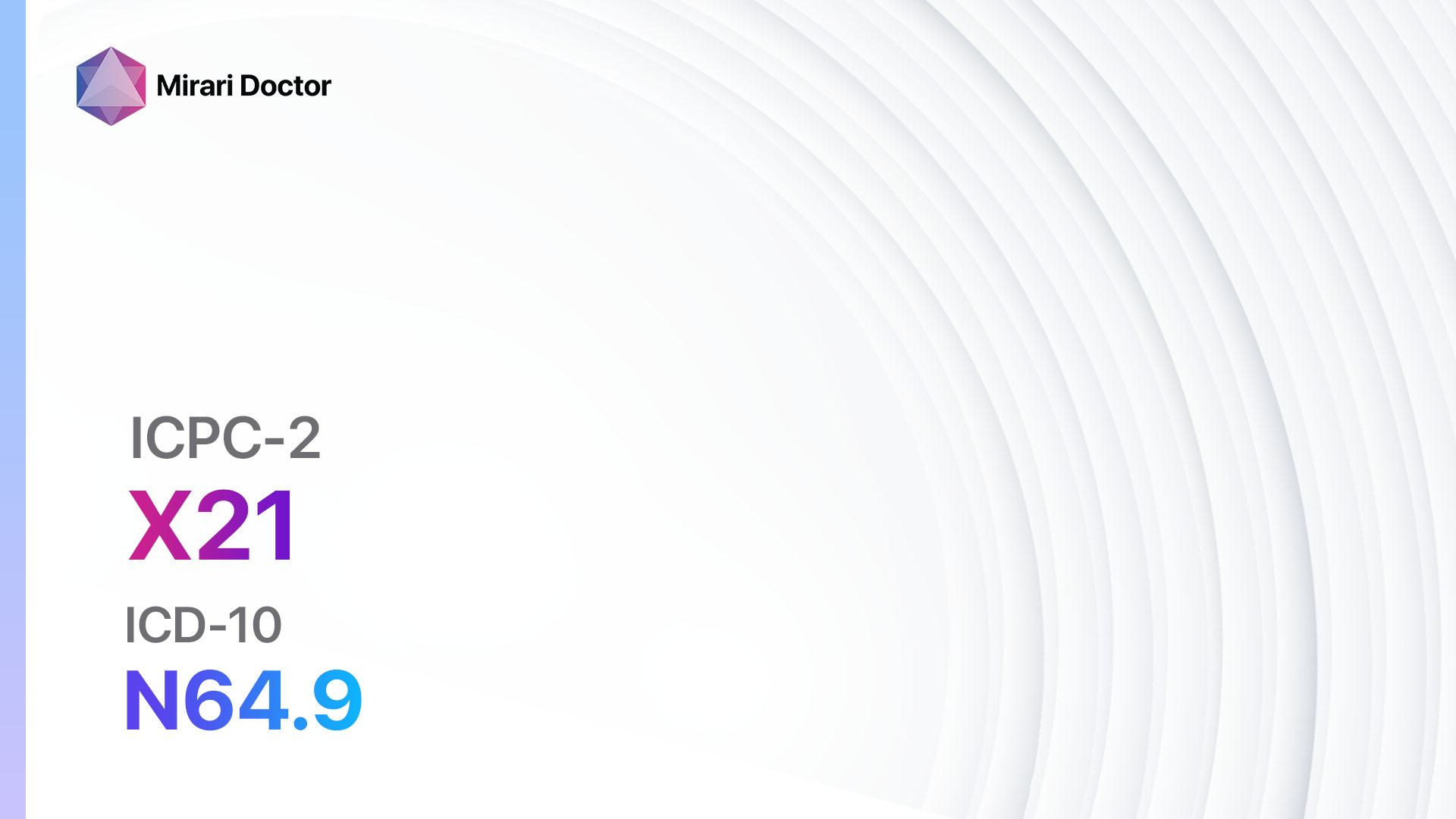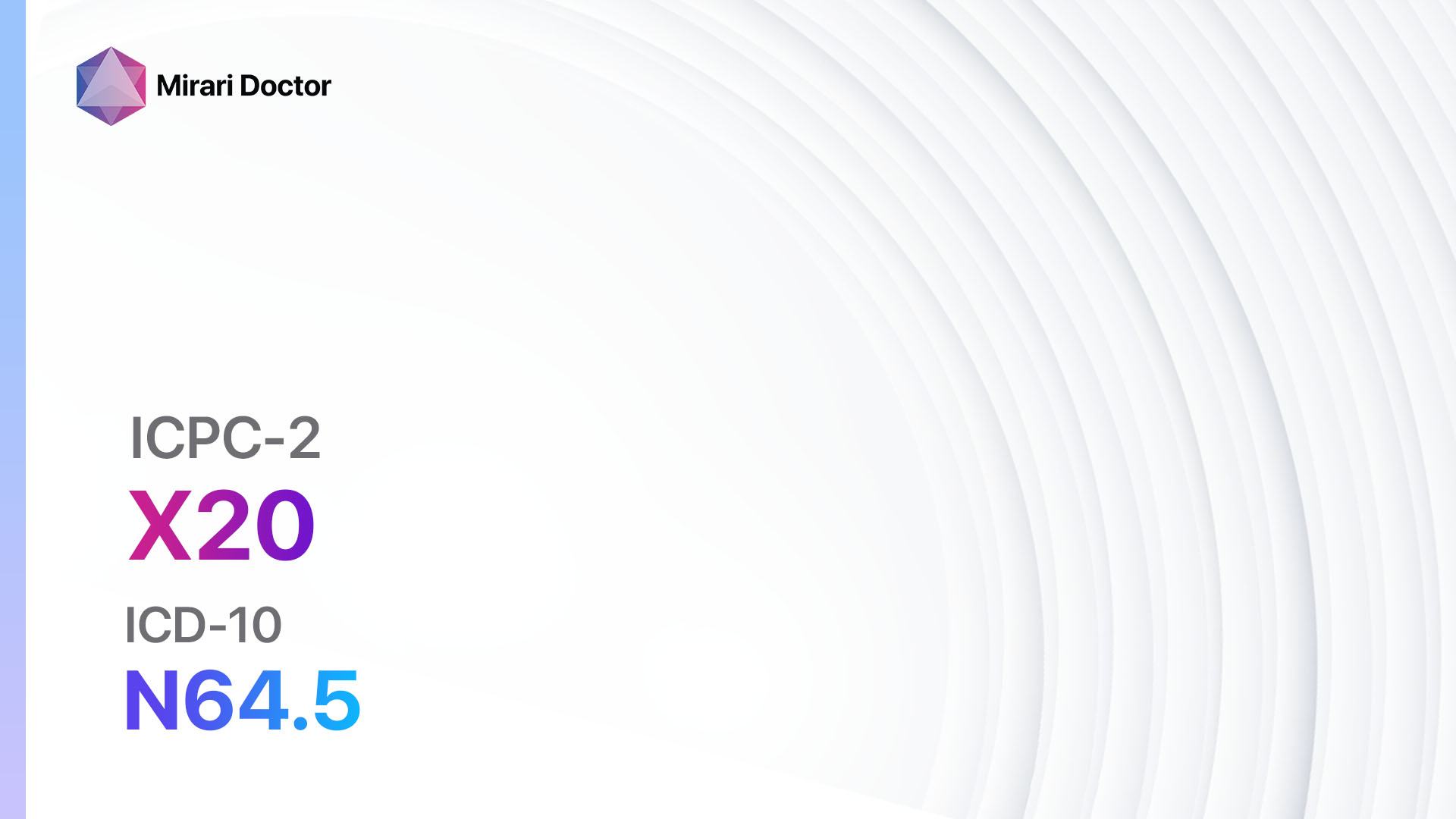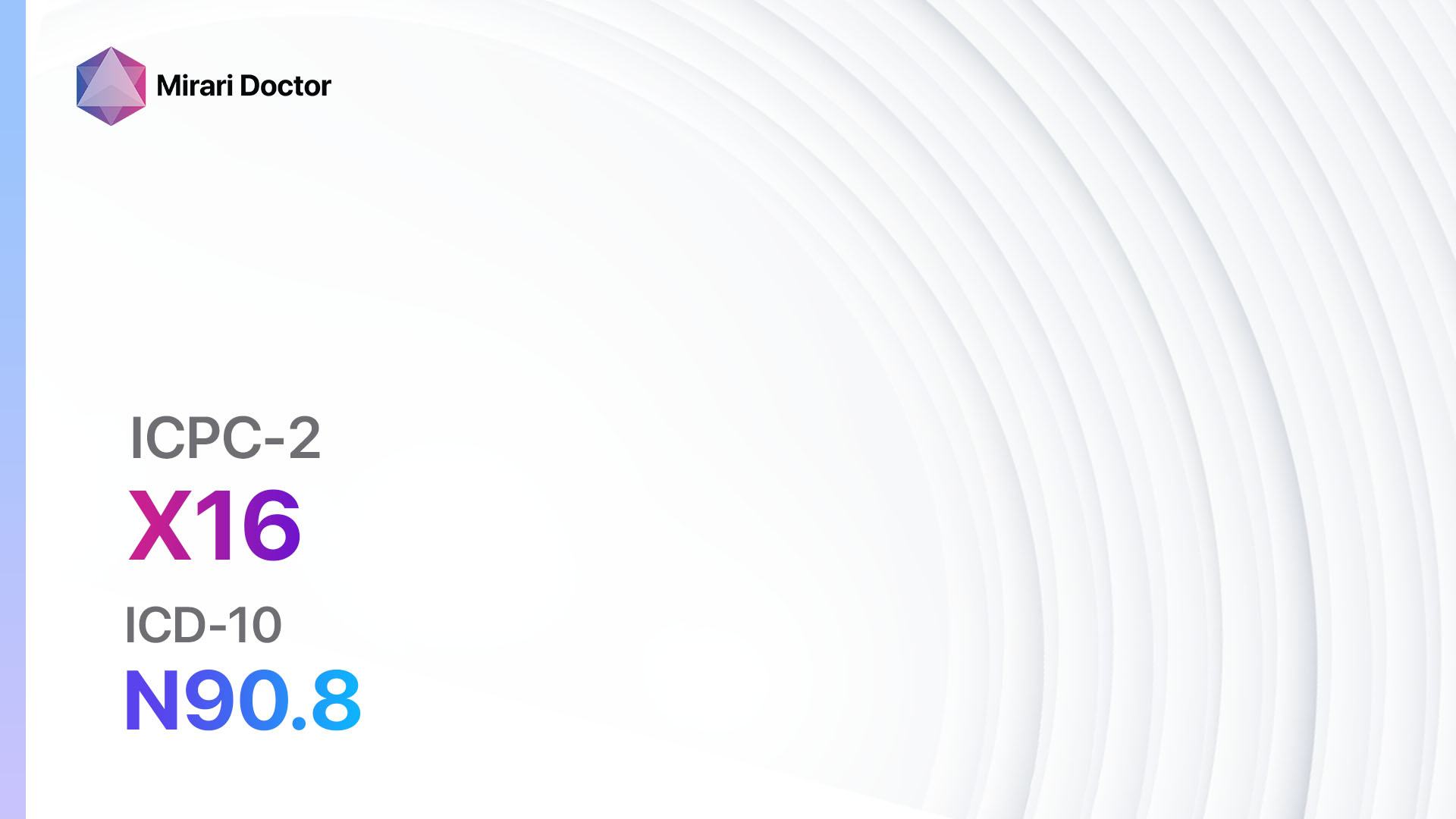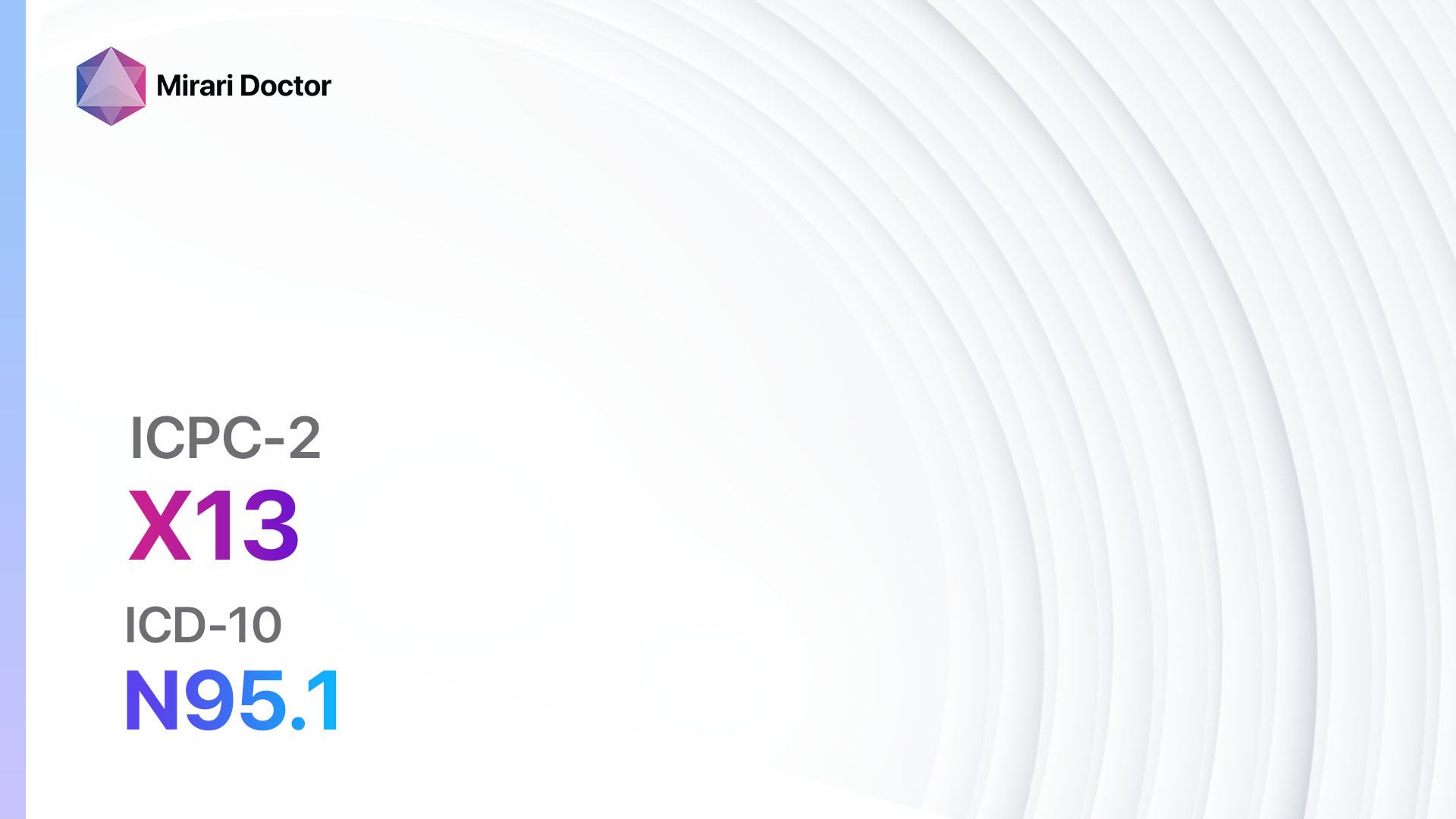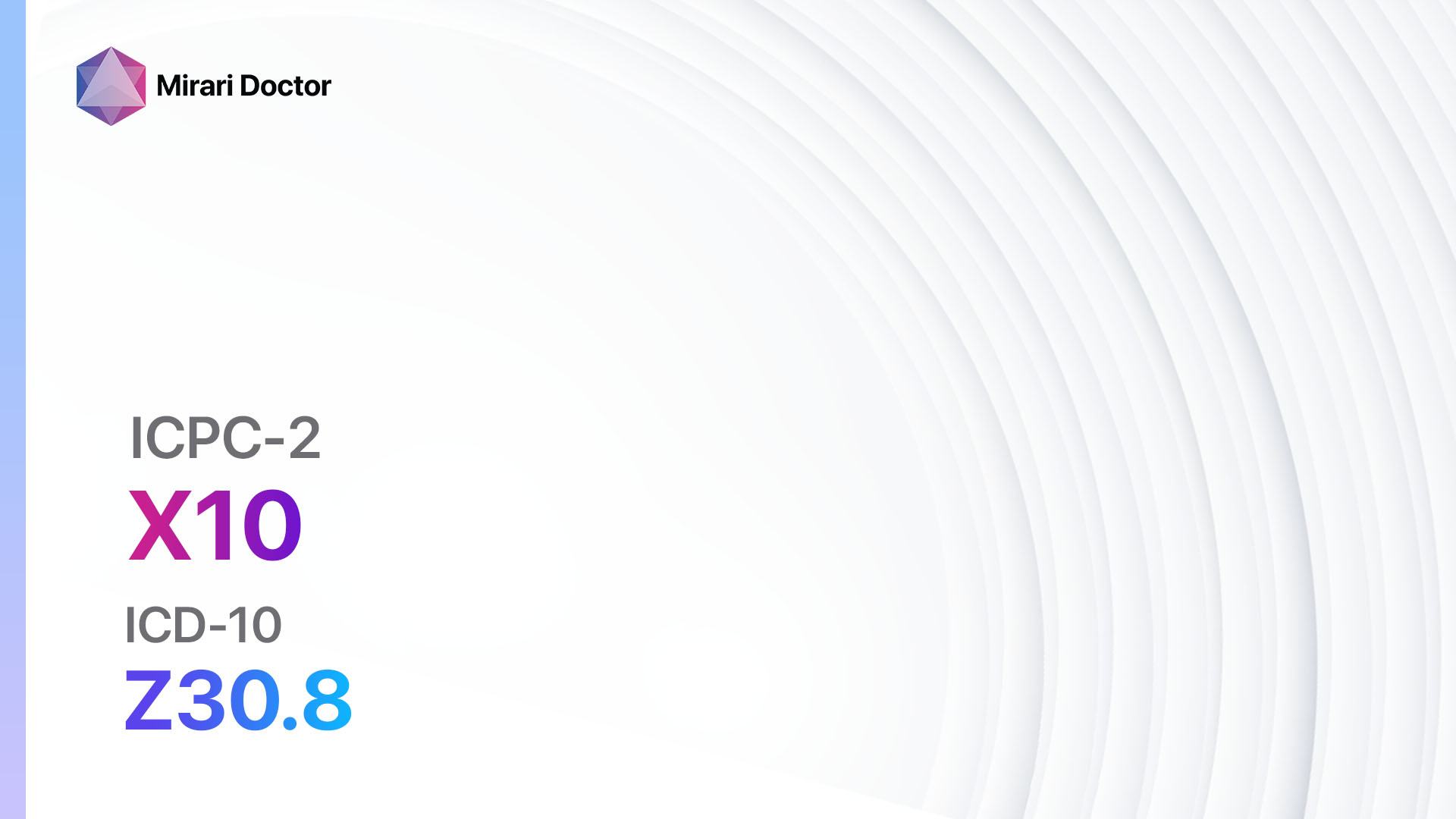
Introduction
Excessive menstruation, also known as menorrhagia, is a condition characterized by abnormally heavy or prolonged menstrual bleeding. It can significantly impact a woman’s quality of life and may be indicative of an underlying health issue[1]. The aim of this guide is to provide healthcare professionals with a comprehensive approach to diagnosing and managing excessive menstruation.
Codes
- ICPC-2 Code: X06 Menstruation excessive
- ICD-10 Code: N92.0 Excessive and frequent menstruation with regular cycle
Symptoms
- Heavy menstrual bleeding that requires changing sanitary protection every hour or more frequently
- Menstrual periods lasting longer than seven days
- Passing blood clots larger than a quarter
- Fatigue or shortness of breath due to anemia
- Pain or cramping in the lower abdomen or back during menstruation[2]
Causes
- Hormonal imbalances, such as anovulation or polycystic ovary syndrome (PCOS)
- Uterine fibroids or polyps
- Adenomyosis (thickening of the uterine lining)
- Endometriosis (growth of uterine tissue outside the uterus)
- Pelvic inflammatory disease (PID)
- Blood clotting disorders
- Certain medications, such as anticoagulants or hormonal contraceptives
- Intrauterine device (IUD) complications[3][4]
Diagnostic Steps
Medical History
- Gather information about the patient’s menstrual cycle, including the duration, frequency, and amount of bleeding
- Inquire about any previous diagnoses or treatments related to excessive menstruation
- Assess the patient’s medical history, including any underlying conditions or medications that may contribute to the symptoms
- Ask about the presence of other symptoms, such as pelvic pain or abnormal vaginal discharge[5]
Physical Examination
- Perform a pelvic examination to assess the size, shape, and condition of the uterus and ovaries
- Check for any abnormalities, such as fibroids, polyps, or signs of infection
- Evaluate the patient’s general health, including vital signs and signs of anemia[6]
Laboratory Tests
- Complete blood count (CBC) to assess for anemia and blood clotting disorders
- Thyroid function tests to rule out thyroid abnormalities
- Coagulation profile to evaluate blood clotting factors
- Hormone level testing, including follicle-stimulating hormone (FSH), luteinizing hormone (LH), and estradiol, to assess for hormonal imbalances[7]
Diagnostic Imaging
- Transvaginal ultrasound to visualize the uterus and ovaries and detect any structural abnormalities
- Hysteroscopy to directly visualize the uterine cavity and identify polyps, fibroids, or other abnormalities
- Magnetic resonance imaging (MRI) may be necessary for a more detailed evaluation of the pelvic organs[8]
Other Tests
- Endometrial biopsy to obtain a sample of the uterine lining for further evaluation and to rule out endometrial cancer
- Sonohysterography, a procedure in which saline is injected into the uterus to enhance visualization during ultrasound
- Genetic testing for blood clotting disorders, if indicated based on the patient’s medical history or family history[9]
Follow-up and Patient Education
- Schedule a follow-up appointment to discuss the results of diagnostic tests and determine the appropriate treatment plan
- Provide the patient with educational materials about excessive menstruation, including potential causes and treatment options
- Address any concerns or questions the patient may have and ensure they understand the importance of regular follow-up care[10]
Possible Interventions
Traditional Interventions
Medications:
Top 5 drugs for excessive menstruation:
- Combined oral contraceptives (e.g., ethinyl estradiol and levonorgestrel):
- Cost: $20-$50 per month.
- Contraindications: History of blood clots, certain types of cancer, liver disease.
- Side effects: Nausea, breast tenderness, breakthrough bleeding.
- Severe side effects: Blood clots, stroke, heart attack.
- Drug interactions: Certain antibiotics, anticonvulsants.
- Warning: Increased risk of blood clots in women over 35 who smoke.
- Tranexamic acid:
- Cost: $50-$100 per month.
- Contraindications: History of blood clots, active thromboembolic disease.
- Side effects: Nausea, diarrhea, headache.
- Severe side effects: Allergic reactions, visual disturbances.
- Drug interactions: None reported.
- Warning: Not recommended for patients with renal impairment.
- Nonsteroidal anti-inflammatory drugs (NSAIDs) (e.g., ibuprofen, naproxen):
- Cost: $5-$20 per month.
- Contraindications: History of gastrointestinal bleeding, kidney disease.
- Side effects: Upset stomach, heartburn, dizziness.
- Severe side effects: Gastrointestinal bleeding, kidney damage.
- Drug interactions: Blood thinners, certain antidepressants.
- Warning: Prolonged use may increase the risk of cardiovascular events.
- Progestin-only contraceptives (e.g., norethindrone):
- Cost: $20-$50 per month.
- Contraindications: History of blood clots, certain types of cancer, liver disease.
- Side effects: Irregular bleeding, mood changes, weight gain.
- Severe side effects: Blood clots, stroke, heart attack.
- Drug interactions: Certain antibiotics, anticonvulsants.
- Warning: Increased risk of blood clots in women over 35 who smoke.
- Gonadotropin-releasing hormone (GnRH) agonists (e.g., leuprolide):
- Cost: $500-$1000 per month.
- Contraindications: Pregnancy, undiagnosed vaginal bleeding, osteoporosis.
- Side effects: Hot flashes, vaginal dryness, mood changes.
- Severe side effects: Bone loss, increased risk of fractures.
- Drug interactions: None reported.
- Warning: Long-term use may lead to decreased bone density.
Alternative Drugs:
- Danazol: A synthetic androgen that can reduce menstrual bleeding. Cost: $200-$500 per month.
- Mefenamic acid: A nonsteroidal anti-inflammatory drug specifically used for menstrual pain. Cost: $10-$30 per month.
- Gestrinone: A synthetic steroid that can reduce menstrual bleeding. Cost: $200-$500 per month.
- Desmopressin: A medication that promotes clotting and can be used for bleeding disorders. Cost: $100-$300 per month.
- Tranexamic acid mouthwash: A topical application of tranexamic acid for localized bleeding. Cost: $50-$100 per month.
Surgical Procedures:
- Endometrial ablation: A procedure to remove or destroy the uterine lining. Cost: $5,000-$10,000.
- Hysterectomy: Surgical removal of the uterus. Cost: $10,000-$20,000.
Alternative Interventions
- Acupuncture: May help regulate menstrual flow and reduce pain. Cost: $60-$120 per session.
- Herbal supplements: Certain herbs, such as vitex agnus-castus or ginger, may have potential benefits for reducing excessive menstrual bleeding. Cost: Varies depending on the specific supplement.
- Dietary modifications: Increasing iron-rich foods and reducing caffeine and alcohol intake may help manage symptoms. Cost: Varies depending on dietary choices.
- Stress reduction techniques: Practices such as yoga, meditation, or mindfulness may help alleviate symptoms. Cost: Varies depending on the chosen method.
- Exercise: Regular physical activity can help regulate hormonal balance and improve overall health. Cost: Varies depending on the chosen activity.
Lifestyle Interventions
- Maintain a healthy weight: Excess weight can contribute to hormonal imbalances and exacerbate excessive menstruation. Cost: Varies depending on dietary choices and exercise habits.
- Practice stress management: Stress can impact hormonal balance and menstrual regularity. Cost: Varies depending on the chosen stress management techniques.
- Use heat therapy: Applying a heating pad or taking warm baths can help alleviate menstrual pain and reduce blood flow. Cost: Varies depending on the chosen method.
- Stay hydrated: Drinking an adequate amount of water can help maintain overall health and regulate menstrual flow. Cost: Varies depending on access to clean drinking water.
- Get enough sleep: Adequate sleep is essential for hormonal balance and overall well-being. Cost: Varies depending on sleep habits and access to comfortable sleeping arrangements.
It is important to note that the cost ranges provided are approximate and may vary depending on the location and availability of the interventions.
Mirari Cold Plasma Alternative Intervention
Understanding Mirari Cold Plasma
- Safe and Non-Invasive Treatment: Mirari Cold Plasma is a safe and non-invasive treatment option for various skin conditions. It does not require incisions, minimizing the risk of scarring, bleeding, or tissue damage.
- Efficient Extraction of Foreign Bodies: Mirari Cold Plasma facilitates the removal of foreign bodies from the skin by degrading and dissociating organic matter, allowing easier access and extraction.
- Pain Reduction and Comfort: Mirari Cold Plasma has a local analgesic effect, providing pain relief during the treatment, making it more comfortable for the patient.
- Reduced Risk of Infection: Mirari Cold Plasma has antimicrobial properties, effectively killing bacteria and reducing the risk of infection.
- Accelerated Healing and Minimal Scarring: Mirari Cold Plasma stimulates wound healing and tissue regeneration, reducing healing time and minimizing the formation of scars.
Mirari Cold Plasma Prescription
Video instructions for using Mirari Cold Plasma Device – X06 Menstruation excessive (ICD-10:N92.0)
| Mild | Moderate | Severe |
| Mode setting: 2 (Wound Healing) Location: 2 (Prostate & Uterus) Morning: 15 minutes, Evening: 15 minutes | Mode setting: 2 (Wound Healing) Location: 2 (Prostate & Uterus) Morning: 30 minutes, Lunch: 30 minutes, Evening: 30 minutes | Mode setting: 2 (Wound Healing) Location: 2 (Prostate & Uterus) Morning: 30 minutes, Lunch: 30 minutes, Evening: 30 minutes |
| Mode setting: 7 (Immunotherapy) Location: 1 (Sacrum) Morning: 15 minutes, Evening: 15 minutes | Mode setting: 7 (Immunotherapy) Location: 1 (Sacrum) Morning: 30 minutes, Lunch: 30 minutes, Evening: 30 minutes | Mode setting: 7 (Immunotherapy) Location: 1 (Sacrum) Morning: 30 minutes, Lunch: 30 minutes, Evening: 30 minutes |
| Total Morning:30minutesapprox.$5USD, Evening:30minutesapprox.$5USD | Total Morning:60minutesapprox.$10USD, Lunch:60minutesapprox. $10 USD, Evening:60minutesapprox. $10 USD, | Total Morning:60minutesapprox.$10USD, Lunch:60minutesapprox. $10 USD, Evening:60minutesapprox. $10 USD, |
| Usualtreatmentfor7-60daysapprox.$70USD–$600USD | Usualtreatmentfor6-8weeksapprox.$1,260USD–$1,680USD | Usualtreatmentfor3-6monthsapprox.$2,700USD–$5,400USD |
 |
|
Use the Mirari Cold Plasma device to treat Menstruation excessive effectively.
WARNING: MIRARI COLD PLASMA IS DESIGNED FOR THE HUMAN BODY WITHOUT ANY ARTIFICIAL OR THIRD PARTY PRODUCTS. USE OF OTHER PRODUCTS IN COMBINATION WITH MIRARI COLD PLASMA MAY CAUSE UNPREDICTABLE EFFECTS, HARM OR INJURY. PLEASE CONSULT A MEDICAL PROFESSIONAL BEFORE COMBINING ANY OTHER PRODUCTS WITH USE OF MIRARI.
Step 1: Cleanse the Skin
- Start by cleaning the affected area of the skin with a gentle cleanser or mild soap and water. Gently pat the area dry with a clean towel.
Step 2: Prepare the Mirari Cold Plasma device
- Ensure that the Mirari Cold Plasma device is fully charged or has fresh batteries as per the manufacturer’s instructions. Make sure the device is clean and in good working condition.
- Switch on the Mirari device using the power button or by following the specific instructions provided with the device.
- Some Mirari devices may have adjustable settings for intensity or treatment duration. Follow the manufacturer’s instructions to select the appropriate settings based on your needs and the recommended guidelines.
Step 3: Apply the Device
- Place the Mirari device in direct contact with the affected area of the skin. Gently glide or hold the device over the skin surface, ensuring even coverage of the area experiencing.
- Slowly move the Mirari device in a circular motion or follow a specific pattern as indicated in the user manual. This helps ensure thorough treatment coverage.
Step 4: Monitor and Assess:
- Keep track of your progress and evaluate the effectiveness of the Mirari device in managing your Menstruation excessive. If you have any concerns or notice any adverse reactions, consult with your health care professional.
Note
This guide is for informational purposes only and should not replace the advice of a medical professional. Always consult with your healthcare provider or a qualified medical professional for personal advice, diagnosis, or treatment. Do not solely rely on the information presented here for decisions about your health. Use of this information is at your own risk. The authors of this guide, nor any associated entities or platforms, are not responsible for any potential adverse effects or outcomes based on the content.
Mirari Cold Plasma System Disclaimer
- Purpose: The Mirari Cold Plasma System is a Class 2 medical device designed for use by trained healthcare professionals. It is registered for use in Thailand and Vietnam. It is not intended for use outside of these locations.
- Informational Use: The content and information provided with the device are for educational and informational purposes only. They are not a substitute for professional medical advice or care.
- Variable Outcomes: While the device is approved for specific uses, individual outcomes can differ. We do not assert or guarantee specific medical outcomes.
- Consultation: Prior to utilizing the device or making decisions based on its content, it is essential to consult with a Certified Mirari Tele-Therapist and your medical healthcare provider regarding specific protocols.
- Liability: By using this device, users are acknowledging and accepting all potential risks. Neither the manufacturer nor the distributor will be held accountable for any adverse reactions, injuries, or damages stemming from its use.
- Geographical Availability: This device has received approval for designated purposes by the Thai and Vietnam FDA. As of now, outside of Thailand and Vietnam, the Mirari Cold Plasma System is not available for purchase or use.
References
- American College of Obstetricians and Gynecologists. (2019). Heavy Menstrual Bleeding. Retrieved from//www.acog.org/patient-resources/faqs/gynecologic-problems/heavy-menstrual-bleeding
- Centers for Disease Control and Prevention. (2021). Heavy Menstrual Bleeding. Retrieved from//www.cdc.gov/ncbddd/blooddisorders/women/menorrhagia.html
- Munro, M. G., Critchley, H. O., Broder, M. S., & Fraser, I. S. (2011). FIGO classification system (PALM-COEIN) for causes of abnormal uterine bleeding in nongravid women of reproductive age. International Journal of Gynecology & Obstetrics, 113(1), 3-13.
- Whitaker, L., & Critchley, H. O. (2016). Abnormal uterine bleeding. Best Practice & Research Clinical Obstetrics & Gynaecology, 34, 54-65.
- National Institute for Health and Care Excellence. (2018). Heavy menstrual bleeding: assessment and management. NICE guideline [NG88].
- American Society for Reproductive Medicine. (2012). Indications and options for endometrial ablation. Fertility and Sterility, 98(5), 1160-1167.
- Matteson, K. A., & Clark, M. A. (2010). Questioning our questions: do frequently asked questions adequately cover the aspects of women’s lives most affected by abnormal uterine bleeding? Opinions of women with abnormal uterine bleeding participating in focus group discussions. Women & Health, 50(2), 195-211.
- Maheux-Lacroix, S., Li, F., Laberge, P. Y., & Abbott, J. (2016). Imaging for polyps and leiomyomas in women with abnormal uterine bleeding: a systematic review. Obstetrics & Gynecology, 128(6), 1425-1436.
- Munro, M. G., Critchley, H. O., & Fraser, I. S. (2011). The FIGO classification of causes of abnormal uterine bleeding in the reproductive years. Fertility and Sterility, 95(7), 2204-2208.
- Matteson, K. A., Rahn, D. D., Wheeler, T. L., Casiano, E., Siddiqui, N. Y., Harvie, H. S., … & Murphy, M. (2013). Nonsurgical management of heavy menstrual bleeding: a systematic review. Obstetrics & Gynecology, 121(3), 632-643.
Related articles
Made in USA














